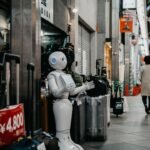Artificial Intelligence (AI) has permeated various sectors, revolutionizing how we approach tasks and solve problems. One of the most promising applications of AI is in education, particularly through AI tutoring systems. These systems leverage advanced algorithms and machine learning techniques to provide personalized learning experiences for students.
By analyzing individual learning patterns, preferences, and performance metrics, AI tutoring systems can adapt their teaching methods to meet the unique needs of each learner. This innovation not only enhances the educational experience but also raises questions about the evolving role of teachers in a landscape increasingly dominated by technology. The integration of AI into education is not merely a trend; it represents a significant shift in pedagogical approaches.
Traditional teaching methods often rely on a one-size-fits-all model, which can leave many students behind. In contrast, AI tutoring systems offer tailored instruction that can address specific gaps in knowledge and skills. As these systems become more sophisticated, they promise to transform the educational landscape, making learning more accessible and effective for diverse student populations.
However, this transformation also necessitates a critical examination of how these technologies will coexist with human educators and the essential role they play in fostering a holistic learning environment.
Key Takeaways
- AI tutoring systems are revolutionizing the way students learn by providing personalized and interactive support.
- Teachers play a crucial role in education, providing mentorship, guidance, and emotional support to students.
- The rise of AI tutoring systems is driven by advancements in technology, allowing for more efficient and accessible learning experiences.
- AI tutoring systems work by using algorithms to analyze student data and provide tailored learning materials and feedback.
- The benefits of AI tutoring systems include personalized learning, accessibility, and the ability to track student progress.
The Role of Teachers in Education
Teachers have long been regarded as the cornerstone of the educational system. They are not only responsible for imparting knowledge but also for nurturing critical thinking, creativity, and social skills among students. The multifaceted role of teachers extends beyond mere instruction; they serve as mentors, counselors, and facilitators of learning.
Their ability to connect with students on a personal level is crucial in creating an environment conducive to learning. This human element is what distinguishes effective teaching from rote memorization and passive learning. Moreover, teachers play a vital role in assessing student progress and providing feedback that is essential for growth.
They can identify when a student is struggling and offer support that goes beyond academic content, addressing emotional and psychological needs as well. This holistic approach to education fosters resilience and encourages students to develop a love for learning. As we explore the rise of AI tutoring systems, it is essential to recognize that while technology can enhance educational practices, it cannot replace the nuanced understanding and empathy that human teachers bring to the classroom.
The Rise of AI Tutoring Systems

The emergence of AI tutoring systems can be traced back to advancements in machine learning and natural language processing. These technologies have enabled the development of intelligent systems capable of simulating human-like interactions and providing personalized feedback. Companies like Carnegie Learning and Knewton have pioneered AI-driven platforms that adapt to individual student needs, offering customized exercises and resources based on real-time performance data.
The increasing availability of data and computational power has accelerated the growth of these systems, making them more accessible to schools and learners worldwide. The COVID-19 pandemic further catalyzed the adoption of AI tutoring systems as educational institutions sought innovative solutions to address remote learning challenges. With traditional classroom settings disrupted, educators turned to technology to maintain continuity in instruction.
AI tutoring systems emerged as valuable tools for delivering personalized learning experiences, allowing students to progress at their own pace while receiving immediate feedback. This shift highlighted the potential of AI to complement traditional teaching methods, paving the way for a more integrated approach to education.
How AI Tutoring Systems Work
AI tutoring systems operate through a combination of algorithms, data analytics, and user interaction. At their core, these systems utilize machine learning models that analyze vast amounts of data to identify patterns in student behavior and performance. When a student engages with an AI tutoring platform, their responses are tracked and analyzed in real-time.
This data informs the system’s understanding of the student’s strengths and weaknesses, enabling it to tailor content accordingly. For instance, if a student struggles with a particular math concept, the AI system can provide additional practice problems focused on that area while gradually increasing complexity as the student demonstrates mastery. Furthermore, these systems often incorporate gamification elements to enhance engagement, making learning more enjoyable.
By simulating a one-on-one tutoring experience, AI systems can offer explanations, hints, and encouragement similar to what a human tutor would provide, thereby fostering a supportive learning environment.
The Benefits of AI Tutoring Systems
The advantages of AI tutoring systems are manifold, particularly in terms of personalization and accessibility. One of the most significant benefits is their ability to provide individualized instruction tailored to each student’s unique learning style. Unlike traditional classrooms where teachers may struggle to address every student’s needs simultaneously, AI systems can adapt in real-time, ensuring that learners receive the support they require when they need it most.
This level of customization can lead to improved academic outcomes and increased student confidence. Additionally, AI tutoring systems can enhance accessibility for students with diverse learning needs. For instance, learners with disabilities may benefit from adaptive technologies that cater specifically to their requirements.
These systems can offer alternative formats for content delivery or adjust pacing based on individual capabilities. Moreover, AI tutoring platforms are often available 24/7, allowing students to access resources outside traditional school hours. This flexibility empowers learners to take control of their education and engage with material at their own pace.
The Limitations of AI Tutoring Systems

Despite their numerous benefits, AI tutoring systems are not without limitations. One significant concern is the potential for over-reliance on technology at the expense of human interaction. While these systems can provide valuable support, they lack the emotional intelligence and empathy that human teachers offer.
The nuances of human communication—such as understanding body language or providing encouragement during challenging moments—are difficult for AI to replicate fully. Consequently, students may miss out on essential social interactions that contribute to their overall development. Moreover, there are concerns regarding data privacy and security when using AI tutoring systems.
These platforms often collect sensitive information about students’ performance and learning habits, raising questions about how this data is stored and used. Ensuring that student data is protected from breaches or misuse is paramount as educational institutions increasingly adopt these technologies. Additionally, there is a risk that AI systems may inadvertently reinforce biases present in their training data, leading to inequitable educational outcomes for certain groups of students.
The Potential Impact on Teachers
The rise of AI tutoring systems has profound implications for teachers and their roles within educational settings. As these technologies become more integrated into classrooms, educators may find themselves shifting from traditional instructional roles to facilitators of learning experiences. Rather than delivering content directly, teachers may focus on guiding students in their interactions with AI systems, helping them navigate challenges and encouraging critical thinking about the material presented.
This shift could also lead to a redefinition of professional development for educators. Teachers will need training not only in how to use these technologies effectively but also in understanding their limitations and potential biases. By equipping educators with the skills necessary to integrate AI into their teaching practices thoughtfully, schools can ensure that technology enhances rather than detracts from the educational experience.
The Role of Teachers in a World with AI Tutoring Systems
In a world increasingly influenced by AI tutoring systems, the role of teachers will evolve rather than diminish. Educators will remain essential in fostering critical thinking skills and promoting creativity among students—qualities that are difficult for machines to replicate fully. Teachers will also play a crucial role in mentoring students through complex emotional landscapes that arise during their educational journeys.
By providing guidance and support during challenging times, teachers can help students develop resilience and perseverance. Furthermore, teachers will be instrumental in curating content and resources that align with curricular goals while ensuring that students engage with diverse perspectives. As AI systems provide personalized recommendations based on data analysis, educators will need to critically evaluate these suggestions to ensure they align with pedagogical best practices and promote equity in education.
In this way, teachers will act as both advocates for their students and stewards of technology within the classroom.
The Importance of Human Connection in Education
The significance of human connection in education cannot be overstated. Research consistently shows that positive relationships between teachers and students contribute significantly to academic success and emotional well-being. These connections foster trust and create safe spaces where students feel comfortable expressing themselves and taking risks in their learning journeys.
While AI tutoring systems can provide valuable support, they cannot replace the depth of understanding that comes from human interactions. Moreover, human connection plays a vital role in developing social skills and emotional intelligence among students. Collaborative activities facilitated by teachers encourage teamwork and communication—skills essential for success in both academic settings and future workplaces.
As we embrace technological advancements in education, it is crucial to prioritize opportunities for meaningful interactions between students and educators.
The Future of AI Tutoring Systems and Teaching
Looking ahead, the future of AI tutoring systems in education appears promising yet complex. As technology continues to advance, we can expect even more sophisticated platforms capable of providing highly personalized learning experiences. These systems may incorporate elements such as virtual reality or augmented reality to create immersive educational environments that engage students on multiple levels.
However, this evolution must be approached thoughtfully to ensure that technology complements rather than replaces traditional teaching methods. Additionally, ongoing research into the effectiveness of AI tutoring systems will be essential in shaping their development and implementation within educational contexts. Educators must remain actively involved in this process to ensure that these technologies align with pedagogical goals and address the diverse needs of learners effectively.
Finding a Balance: Integrating AI Tutoring Systems with Teacher Support
The key to harnessing the potential of AI tutoring systems lies in finding a balance between technology and human support within educational settings. Schools should aim for an integrated approach where AI serves as a tool that enhances teaching rather than replacing it entirely. By leveraging the strengths of both human educators and intelligent systems, we can create an enriched learning environment that meets the needs of all students.
Professional development programs should focus on equipping teachers with the skills necessary to effectively integrate AI into their classrooms while emphasizing the importance of maintaining strong relationships with students. Collaboration between educators and technologists will be crucial in developing tools that genuinely support teaching practices rather than detract from them. Ultimately, by prioritizing both technological innovation and human connection, we can create an educational landscape that prepares students for success in an increasingly complex world.









